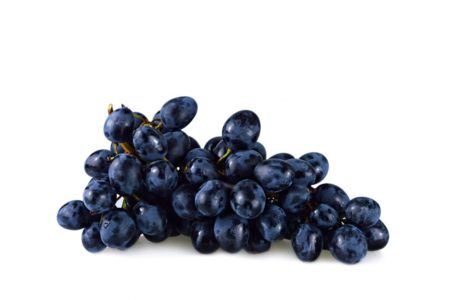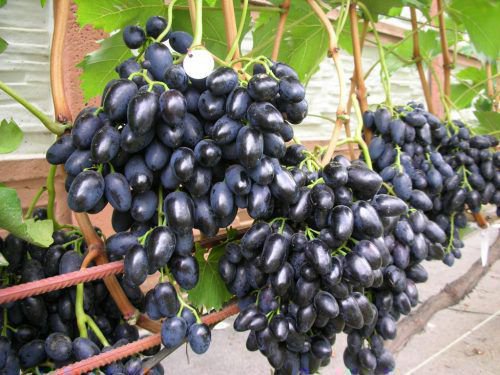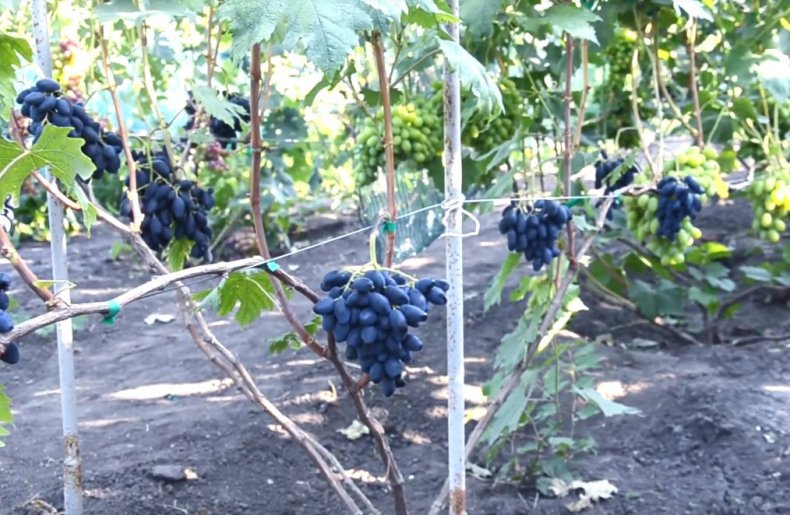Rhombic is a promising hybrid form of grape, bred in 2010 by crossing such varieties as Super Extra and Beauty. The author is Evgeny Georgievich Pavlovsky. Gardeners willingly share photos and reviews about the novelty, characterize it as early ripe, tasty, resistant to adverse weather conditions and a very unpretentious variety of grapes. Rhombic is worthy of the attention of beginners and experienced growers.
Content
Description and characteristics of Rhombic grapes
 The hybrid is super early, the crop is harvested 80–90 days after the buds open, depending on the region, the ripening period falls in mid-July or early August. If, at the beginning of the growing season, the frost affected the vine, some of the buds will be lost, and the berries will ripen 10-15 days later. Adult bushes withstand frosts up to 23 degrees, immunity to diseases is high, berries are not damaged by wasps, birds and other pests.
The hybrid is super early, the crop is harvested 80–90 days after the buds open, depending on the region, the ripening period falls in mid-July or early August. If, at the beginning of the growing season, the frost affected the vine, some of the buds will be lost, and the berries will ripen 10-15 days later. Adult bushes withstand frosts up to 23 degrees, immunity to diseases is high, berries are not damaged by wasps, birds and other pests.
The bushes are massive, tall, shoots are highly branched, the ripening of the vine is excellent. The plant begins to bear fruit 2 years after planting. The leaves are carved, very beautiful, leafy bush average. The flowers are bisexual; when planting a hybrid, you do not need to select pollinating varieties for it. The clusters are conical from 500 grams to kilograms, loose, but not loose.
The berries are rhomboid, dark purple or black, mostly large (10-18 grams), there are very few small fruits in the hands. The flesh is crispy, sour-sweet, juicy, with a fruity note and a subtle muscat flavor. The peel is almost not felt when consumed, there are few seeds.
Unripe berries leave a weak astringent aftertaste, and when re-ripening, when they start to fade, the taste becomes sweeter and more saturated, some gardeners compare it with prunes, and others with dried cherries. The fully ripened berries do not burst even with excessive moisture, they are difficult to come off the stalks, due to which they do not crumble.
Productivity and Use
 In the description from the originator, Rhombic grapes are declared as a high-yielding, stable form. The same information is also confirmed by many winegrowers, but there is no exact information on the amount of harvested crop for one season. Some boast that a year after planting, the bush gave about 1.5 kilograms of berries, while others complain that by the third season only 5 inflorescences had formed on a well-developed plant. Much depends on the age of the bush, the method of pruning and the region of cultivation.
In the description from the originator, Rhombic grapes are declared as a high-yielding, stable form. The same information is also confirmed by many winegrowers, but there is no exact information on the amount of harvested crop for one season. Some boast that a year after planting, the bush gave about 1.5 kilograms of berries, while others complain that by the third season only 5 inflorescences had formed on a well-developed plant. Much depends on the age of the bush, the method of pruning and the region of cultivation.
Rhombic is a table grape, but some gardeners used it to make wine. Despite the good taste of fresh berries, the drink turned out to be fresh, without a fruity aftertaste and rich aroma. Berries can be used to prepare juices and assorted fruits, but they are not suitable for freezing. Harvested crops are stored without damage for up to 2, 5 months in a cellar or refrigerator.
Advantages and disadvantages
For almost 9 years of its existence, the Rombik grape hybrid has established itself only on the positive side.Among the shortcomings, we can distinguish weak resistance to return frosts, as well as a small amount of information regarding the nuances of cultivation in different regions. Some gardeners complain about the relatively low weight of the hands the first 4 years after planting. Note the main advantages:
- early ripening;
- resistance to diseases and pests;
- frost resistance;
- almost complete absence of pea;
- stable, high productivity;
- great taste;
- hybrid self-pollinated;
- the berries do not crumble and do not crack;
- transportability and keeping quality;
- excellent commercial quality brushes.
Another significant advantage of Rhombic grapes is the quick rooting of cuttings, which simplifies the process of propagation of the hybrid. It is also worth noting the ease of cultivation, the hybrid is suitable for beginner growers and for those who do not have time for painstaking care of the bush.
Growing Features
Carefully inspect the seedling before purchase, it should not be any damage (breaks, peeling of the bark, chips or spots). In a healthy stalk, the root is branched, strong, and the kidneys do not fall off when touched. The stem should be light brown, and on the cut green. Before planting, the roots of the seedling are soaked for 2-3 days in water, then they are shortened to 15 cm.
Allocate the grapes a place on a hill or on a slope; in the lowlands, they do not plant a crop or organize reliable drainage. The best option would be the south, sunny, open side of the site, protected from wind and cold drafts. Rhombic grapes can be placed near fences, walls of various buildings, while it is advisable to equip the supports in the form of an arch or arbor.
Landing
Landing pit must be prepared in advance. Dig a hole with a size of 80x80 cm, pour a layer (10-15 cm) of small gravel or broken stone on the bottom. Now a little more than half fill the pit with a mixture of earth with organic fertilizers, leave for several months for shrinkage. In the soil mixture, you can add a half liter jar of wood ash.
In the middle of the prepared hole, make a small depression, expect that after filling the roots with earth, the root neck remains on the surface. For backfill use the soil from the pit dug earlier. Next to the seedling should drive a peg for garter. After planting, pour plenty of grapes, you will need 2 or 3 buckets of water.

Watering and feeding
At the beginning of growth (in the first year after planting), Rhombic grapes need abundant watering, if there is no natural rainfall, pour 20 liters of water under the bush every 10-15 days. From mid-summer, the frequency of watering should be gradually reduced so that the vine has time to ripen before the first autumn frosts. In subsequent years, abundant watering is necessary only in the spring during flowering and during prolonged droughts. After watering and rains, the earth needs to be loosened, and so that the moisture does not evaporate quickly, the mug circle should be mulched with humus or peat.
Fertilizers introduced into the soil during planting will last 3-5 years, then top dressing is carried out regularly, several times during the whole grape growing season. In the early spring (immediately after removing the shelter), in the fall, as well as during the period of mass loading of berries, use chicken droppings, manure or vegetable humus. Before blooming and at the beginning of flowering, spend 2 foliar fertilizing with boric acid - 10 grams per bucket of water.
Prevention
Despite the resistance of the Rhombic grapes to diseases, preventive spraying will not interfere.The first session should be carried out immediately after removal of the shelter, when stable warm weather is established. Treat the bush with 0.5 or 1% aqueous solution of iron sulfate. The procedure will destroy all possible pathogenic fungi and bacteria. The tool is also suitable for autumn processing (before shelter), but a more concentrated solution is needed - 3 or 5%.
Pruning and preparing for winter
Rhombic grape bush can be formed according to any convenient scheme. The main pruning occurs in the fall (shortening shoots, harvesting excess and dry branches), the procedure rejuvenates the bush and stimulates fruiting. In summer, you should break out twisted shoots and clean the stepsons. In the spring, all frost-bitten parts of the bush are removed.
In the south, Rhombic vineyards winter well without shelter, they can be hidden only in the first year after planting or until the first harvest. In regions with a cool or cold climate, protection is indispensable. In the first year, the bush is completely covered in any convenient way, in subsequent years, if possible, the vine is bent to the ground, wrapped or built a kind of greenhouse.
For a short period of time, the hybrid managed to gain a good reputation; it is actively grown in amateur gardens and in industrial, large vineyards. Rhombic is in high demand in the market, they sell it at an inflated price, since the berries ripen long before the mass ripening of the remaining varieties. Lovers of early, delicious berries will definitely like the Rhombic grapes; take a closer look at it.
Reviews
Valery
Rombik bought when there was practically no information about him, he thought about the formation for a long time, immediately left 2 sleeves and did not lose. The bush grows very quickly, I spend pruning every autumn, without fear I remove all unnecessary branches, shorten the main ones. I do not carry out preventive treatments, there were no diseases. I live in the Krasnodar Territory, I do not cover the bush. The hybrid is very easy to grow, and the berries have a taste not quite typical of grapes.
Tatyana
They told me more than once that Rhombic rarely gets sick, my bush was struck by powdery mildew in the third year after planting, but the weather was to blame. I got rid of the problem quickly, I used Topaz. The yield is not bad, about 3, 5 kg from the bush, despite the fact that the vineyard is only the fourth year. In the suburbs, berries fully ripen closer to early August. Last fall, it was not possible to get to the cottage, the bush did not shelter, but he suffered, surprisingly, not too much and quickly recovered.




 Non-covering winter-hardy grape varieties for Moscow region
Non-covering winter-hardy grape varieties for Moscow region How to keep the vine in winter
How to keep the vine in winter When can I transfer grapes to another place in the fall
When can I transfer grapes to another place in the fall How to cover and prepare grapes for the winter in the suburbs
How to cover and prepare grapes for the winter in the suburbs